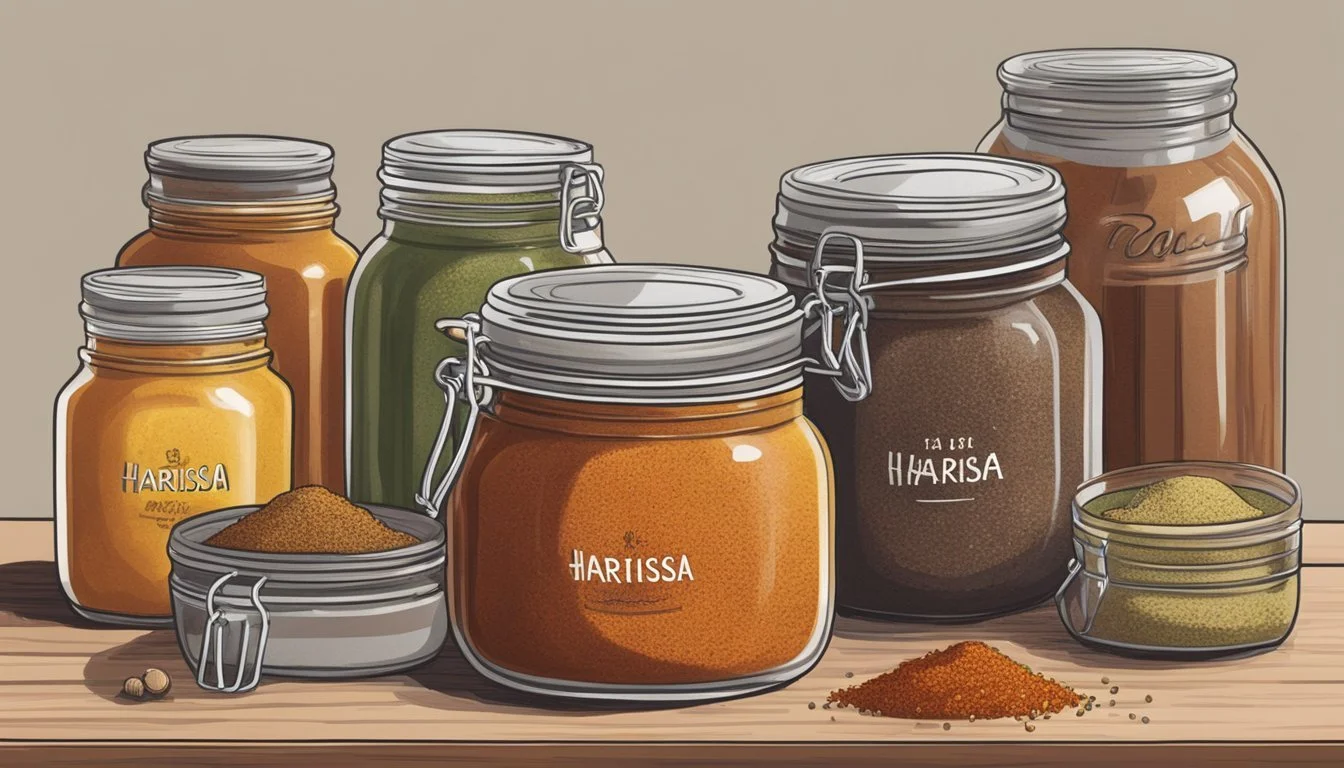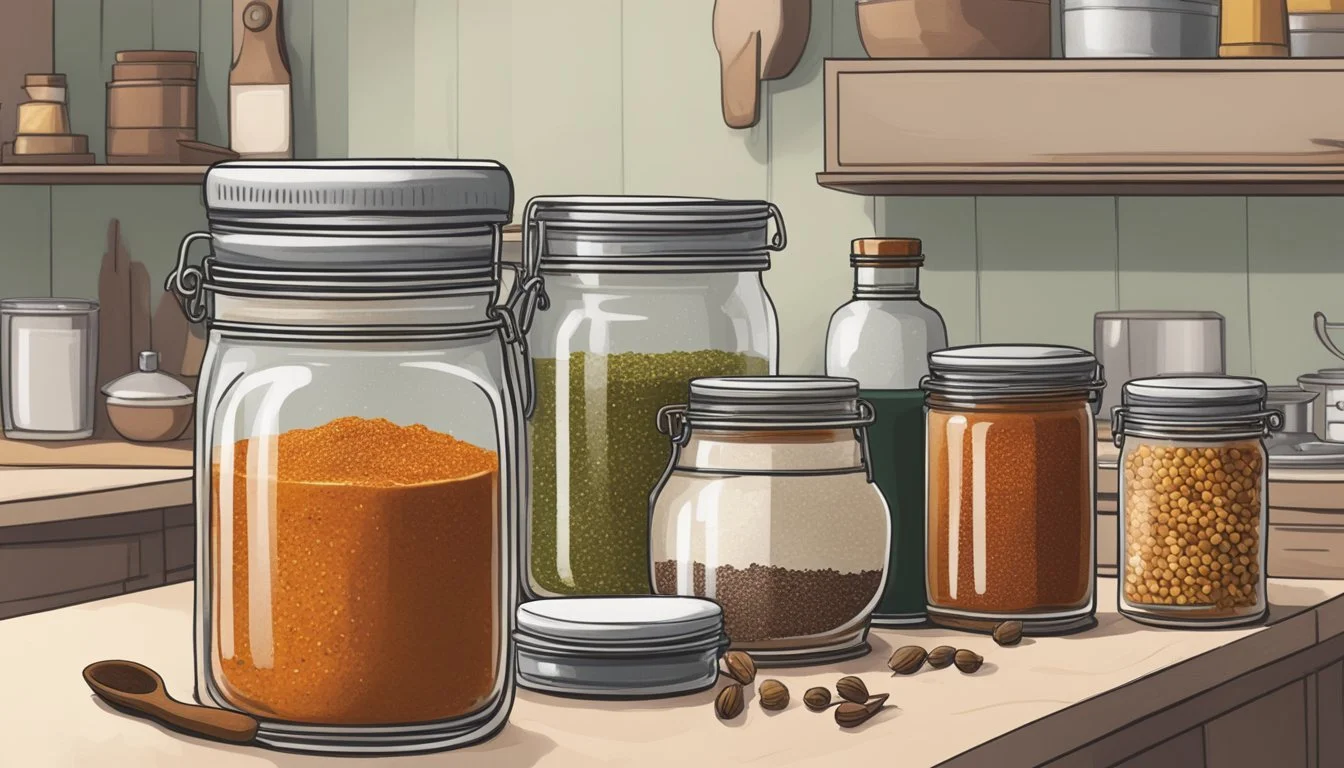Does Harissa Go Bad?
Shelf Life and Storage Tips
Harissa, a vibrant and spicy condiment originating from Tunisia and popular throughout North Africa and the Middle East, brings a burst of flavor to countless dishes. Known for its intense heat, this paste combines various hot peppers, garlic, spices, and oil. Despite its wide-ranging uses and delicious punch, many wonder about its shelf life.
Yes, harissa can indeed go bad. To prevent this, it's crucial to store it properly by protecting it from light, air, heat, and moisture. A practical tip is to top the paste with a thin layer of olive oil before refrigerating it. This helps seal out air and maintain its fiery freshness.
With its distinctive taste and cultural significance, harissa is a kitchen favorite for enhancing everything from meats to vegetables. Yet proper storage is the key to ensuring it remains a flavorful staple in your culinary arsenal.
Understanding Harissa
Harissa is a potent and flavorful spice blend that originates from Tunisia and holds cultural significance in North African and Middle Eastern cuisine. It comprises a mix of spices and herbs, with variations in ingredients and methods of preparation, enhancing a range of dishes from marinades to dips.
Origins and Cultural Significance
Harissa finds its roots in Tunisia, a North African country known for its rich culinary heritage. It is a staple in Tunisian and Moroccan cuisines and has spread widely across Middle Eastern cuisine. Traditionally, harissa is not only a condiment but also an integral spice blend in many cultural recipes.
In Tunisian culture, harissa often accompanies bread and is used liberally in soups, stews, and couscous. Its name, derived from the Arabic word "harasa," meaning "to pound," reflects its traditional preparation method, where ingredients are pounded into a paste.
Ingredients and Variations
Harissa is made from a blend of ingredients that provide a complex flavor profile. Key ingredients typically include red peppers, garlic, olive oil, coriander, caraway, cumin, and occasionally mint. The spice blend is known for its fiery heat and aromatic qualities.
Variations exist depending on geographic and familial recipes. For instance, Moroccan harissa might include roasted red peppers for a smokier flavor, while Tunisian versions may be significantly hotter. Some recipes add tomatoes or rose petals, introducing unique flavors and regional twists.
Homemade Harissa Variations
Homemade harissa paste allows customization of heat and flavor intensity. Key ingredients include dried or fresh red peppers, blended with garlic, olive oil, and spices like coriander, caraway, and cumin. Combining these in a food processor or blender produces a smooth, spicy paste.
One popular homemade variation incorporates roasted red peppers for extra depth. Another involves adding a bit of mint for a fresh, herbaceous note. Chilli types can be adjusted to control heat level, from mild to extremely spicy, allowing a more personalized and versatile paste for various culinary uses.
Culinary Uses of Harissa
Harissa is a versatile ingredient that adds depth and heat to various dishes. Its uses range from being a key component in recipes to serving as a flavorful condiment.
Incorporation in Recipes
Harissa paste can elevate a simple dish with its bold flavors. In Middle Eastern cuisine, it is often added to couscous to enhance its complexity. It's also commonly used in soups, where just a spoonful can transform the broth’s character.
For chicken and meat, harissa serves as an excellent marinade. Mixing it with olive oil and lemon juice before applying it to the meat allows the flavors to penetrate deeply.
It can also be a fantastic addition when cooking fish and vegetables. A dollop of harissa can bring a smoky, peppery note to roasted vegetables or grilled fish.
Harissa as a Condiment
Harissa shines brightly as a condiment due to its spicy, aromatic profile. Mixing it into yogurt creates a spicy dip perfect for vegetables or as a sauce for meat.
Combining harissa with mayo can make a delicious spread for sandwiches, burgers, or a dip for French fries. In vinaigrettes, it provides a piquant kick, ideal for brightening up salads.
Additionally, simply drizzling harissa over dishes, such as a finished grilled chicken or fish, can add a final touch of seasoning and a burst of flavor.
Using it as a hot sauce alternative can also provide an exciting twist to a variety of meals, enhancing the overall dining experience.
Storing Harissa
Proper storage techniques can significantly extend the shelf life of harissa and prevent mold growth. This section covers how to store harissa to maintain its quality and freshness.
Shelf Life and Spoilage Signs
Harissa paste can last up to six months if stored correctly, but it can go bad sooner if not handled properly. Unopened jars can be kept in a dark, cool, and dry place. Once opened, harissa should be checked for mold, strange odor, or change in texture.
To ensure freshness, it is recommended to store opened harissa in a glass jar and cover it with a thin layer of olive oil or vinegar. This creates a barrier against mold. Always use a clean spoon to avoid contamination.
Refrigeration and Freezing Techniques
Once the harissa jar is opened, it should be stored in the fridge to maintain its quality. Covering it with a thin layer of olive oil can help prevent air from reaching the paste, thus prolonging its shelf life. If harissa will not be used quickly, freezing is an option.
Portion the harissa before freezing, as thawing and refreezing can degrade its quality. Labeling the containers with the date of storage is crucial. Thaw the paste in the refrigerator overnight and stir well before use to regain its consistency.
Effective storage methods will preserve the rich, spicy flavors of harissa for extended use.
Comparing Harissa to Other Condiments
Harissa, a North African condiment, stands out from other sauces with its unique flavor and intensity. Its distinct blend of spices and heat levels offers a different experience compared to other spicy condiments like Sriracha or traditional hot sauces.
Harissa Versus Other Spicy Condiments
Harissa is notable for its deep, smoky flavor and complex spice blend. Traditionally made from chili peppers, garlic, olive oil, and spices like caraway seeds and coriander, it adds depth to dishes.
In contrast, Sriracha, a popular hot sauce, features a tangy, mildly sweet flavor profile. It primarily consists of chili peppers, vinegar, garlic, sugar, and salt, giving it a smoother, more balanced heat.
While traditional hot sauces are typically vinegar-based and have a sharp, pungent taste, harissa offers a richer, earthier experience. Moroccan and Middle Eastern cuisines often incorporate harissa to provide a robust, pungent kick, whereas Sriracha is commonly used in Asian cuisines for its mild, citrusy tang.
Flavor Profile and Heat Levels
Harissa’s flavor is characterized by its intense spiciness and aromatic qualities. The blend of spices such as caraway seeds, coriander, and cumin, along with the chili peppers, creates a complex, layered taste. It can range from mildly spicy to intensely hot, depending on the ratio of chiles, providing versatility in heat.
Sriracha offers a consistent, medium-level heat that is less intense than harissa. It combines a balanced sweetness with its spiciness, making it more approachable for a wider audience. Traditional hot sauces, known for their tangy and sharp heat, can be less complex in flavor compared to harissa, focusing more on delivering heat through vinegar and simple spices.
In summary, harissa stands out with its smoky, rich profile and variable heat levels, making it distinct from the more consistent, tangy heat of Sriracha and the pungent sharpness of traditional hot sauces.
Harissa in a Nutritional Context
Harissa is a chili paste rich in both flavor and nutrients. This section explores the primary health benefits and nutritional components of harissa.
Health Benefits and Nutrients
Harissa offers several health benefits due to its rich content of antioxidants and vitamins. A 15-gram serving contains 228 mg of sodium, 10% of the daily value, and low protein content.
Nutritional Components Table:
Nutrient Amount per 15g % Daily Value Carbohydrates Equal to fats - Sodium 228 mg 10% Protein Low -
It includes vitamins C and iron sourced mainly from its peppers, which contribute to a strong immune system and improved energy levels through better iron absorption. This nutritional profile makes harissa a flavorful and beneficial addition to many dishes.
Purchasing and Locating Harissa
Harissa can be found in various forms, including jars, tubes, and powder, and is available at many grocery stores and supermarkets.
Harissa Availability
Grocery Stores: Harissa paste is commonly found in well-stocked grocery stores. It may be located in the international foods aisle, specifically in sections dedicated to Middle Eastern or North African cuisine. It's often available in both jars and tubes.
Supermarkets: Larger supermarkets are also likely to carry harissa. Shoppers might find it near other condiments and spices. Some stores even offer harissa powder, which can be rehydrated into a paste.
Online Retailers: For those unable to find harissa locally, many online retailers offer a variety of options, including specialty brands.








